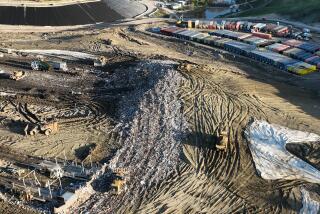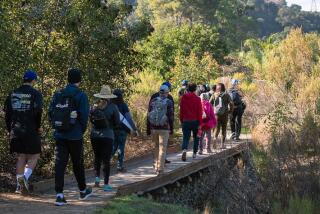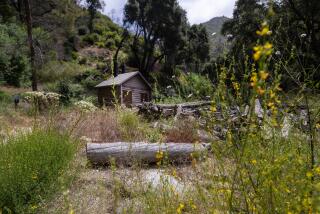Golf Course to Be Rebuilt Over Landfill : Recreation: New 18-hole layout will replace the Scholl Canyon facility, which was closed in 1989 after dangerous levels of methane were released.
GLENDALE — The Scholl Canyon Golf Course, closed four years ago because of dangerous levels of methane leaking from the landfill below, will be rebuilt with a new 18-hole layout under a 40-year lease approved Tuesday by the Glendale City Council.
American Golf Corp. of Santa Monica, the largest municipal golf course operator in the country, has agreed to spend $3.6 million to build an executive-length course and driving range on top of the landfill at the eastern end of Glenoaks Boulevard in the San Rafael Hills.
Terms of the lease call for American Golf to pay the city at least $5.5 million in rent and concession fees over the life of the 40-year agreement.
The course, to be constructed on about 56 acres of the 410-acre landfill, will take 12 to 18 months to complete, said Nello Iacono, director of parks, recreation and community services.
American Golf operates more than 140 courses nationwide and several built on top of landfills, including Brookside in Pasadena and Mountain Gate Country Club in Brentwood.
The city of Glendale would be responsible for any future closures of the course due to environmental problems.
The original nine-hole course built on top of the Scholl Canyon Landfill was plagued with problems even before it opened in 1981. Fairways, greens and a driving range continually shifted as much as 15 feet, and the landscaping was seared by the leaking gas.
Golfers referred to the course as “Stinky Canyon” because of the constant odor of methane. Still, the course, which was the city’s only municipal golf facility, averaged 36,000 rounds of play per year before it was closed in 1989 when methane leaks reached potentially explosive levels.
Flares that were used to burn off the leaking methane were extinguished briefly on July 20, 1989, after the South Coast Air Quality Management District decreed that the equipment did not meet state standards. The flares were reignited about 24 hours later after officials warned that high levels of the gas could gather in nearby areas and explode. No gas clouds were located, however, and the incident passed without further trouble after the air quality agency reversed its order.
Consultants said the landfill is one of the most difficult to deal with, because it is deeper than most--245 feet in some areas--and has had more surface shifting because of the decomposition of underground material.
After the closure, the city installed a flexible pipe system to collect methane naturally produced by the decomposition of trash and is using the gas to generate power to produce electricity, said Kerry L. Morford, assistant public works director.
The old landfill also has been covered with about six feet of dirt trucked in from nearby construction projects, which will serve as a base for landscaping a new course, Iacono said.
A tennis club next to the golf course, also shut down in 1989 because of the noxious gas leakage, was reopened in 1990. The 10 courts, restrooms and a reservations office are on a portion of the site that is not over the landfill.
Iacono said the new course will be longer than the original development. However, the executive-length course will still be shorter than regulation 18-hole courses, such as those at the private Oakmont and Chevy Chase country clubs in Glendale and at Los Angeles city courses in Griffith Park.
More to Read
Sign up for Essential California
The most important California stories and recommendations in your inbox every morning.
You may occasionally receive promotional content from the Los Angeles Times.









